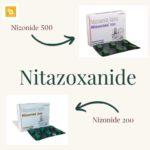Introduction
Nitazoxanide 500 mg is an antiparasitic medication primarily used to treat various gastrointestinal infections caused by protozoa and helminths. It is known for its broad spectrum of activity against a range of parasites and has gained attention for its potential effectiveness against several types of infections. One common question that arises among patients and healthcare providers is whether nitazoxanide is effective in treating tapeworm infections. In this article, we will explore the uses of nitazoxanide, its mechanism of action, the types of infections it treats, and whether it is an effective treatment for tapeworms.
Understanding Tapeworms
Tapeworms are flat, segmented worms belonging to the class Cestoda. They are intestinal parasites that can infect humans and other animals. Tapeworm infections usually occur through the consumption of contaminated food or water, particularly undercooked or raw meat containing tapeworm larvae. The most common types of tapeworms that infect humans include:
- Taenia saginata (beef tapeworm)
- Taenia solium (pork tapeworm)
- Diphyllobothrium latum (fish tapeworm)
Tapeworms can live in the intestines for years without causing significant symptoms. However, some individuals may experience gastrointestinal issues, nutritional deficiencies, and weight loss due to the parasite’s presence.
Nitazoxanide: Overview
Nitazoxanide 200 mg is an antiparasitic and antiviral medication with a broad spectrum of activity against various parasites, including Giardia lamblia, Cryptosporidium parvum, and Entamoeba histolytica. It is marketed under the brand name Alinia and is primarily used for treating diarrhea caused by these protozoan infections.
Mechanism of Action
Nitazoxanide works by inhibiting the enzyme pyruvate ferredoxin oxidoreductase (PFOR), which is essential for anaerobic energy metabolism in parasites. By disrupting this metabolic pathway, nitazoxanide effectively kills or inhibits the growth of a variety of parasites. It is important to note that nitazoxanide is not specifically targeted at helminths (worms) like tapeworms, as its primary effectiveness has been documented against protozoan infections.
Efficacy Against Tapeworms
Currently, there is limited evidence to support the use of nitazoxanide for the treatment of tapeworm infections. Traditional treatments for tapeworm infections involve specific anthelmintic medications that target these types of parasites more effectively. The most commonly used medications for treating tapeworm infections include:
- Praziquantel: This is the first-line treatment for most tapeworm infections. It works by causing severe contraction and paralysis of the tapeworm, leading to its dislodgment from the intestinal wall and subsequent elimination from the body.
- Albendazole: This medication disrupts the metabolic processes of the parasite and is used in certain tapeworm infections, particularly in cases of cysticercosis (caused by Taenia solium).
- Mebendazole: While more commonly used for other helminth infections, mebendazole can also be effective in treating some types of tapeworms.
Limitations of Nitazoxanide for Tapeworms
The primary limitation of using nitazoxanide for tapeworm infections is its lack of specific activity against these helminths. While nitazoxanide has demonstrated effectiveness against various protozoan infections, tapeworms have a different biological structure and metabolic pathway that may not respond to this medication.
Moreover, studies evaluating the effectiveness of nitazoxanide for treating tapeworms are sparse, and existing data do not support its use as a standard treatment. Patients diagnosed with tapeworm infections should consult healthcare professionals for appropriate management and treatment options tailored to their specific condition.
When is Nitazoxanide Prescribed?
Nitazoxanide is primarily prescribed for:
- Giardiasis: An infection caused by the protozoan Giardia lamblia, leading to gastrointestinal symptoms like diarrhea and abdominal pain.
- Cryptosporidiosis: Caused by the protozoan Cryptosporidium parvum, this infection can lead to severe diarrhea, particularly in immunocompromised individuals.
- Amebiasis: An infection caused by Entamoeba histolytica, which can cause intestinal dysentery.
Given its indications, nitazoxanide is most effective in treating these protozoan infections rather than helminthic infections like tapeworms.
Conclusion
While nitazoxanide is an effective treatment for certain protozoan infections, it is not considered a suitable option for treating tapeworm infections. Patients diagnosed with tapeworms should rely on established anthelmintic therapies, such as praziquantel or albendazole, which are specifically designed to target these parasites.
If you suspect you have a tapeworm infection or are experiencing gastrointestinal symptoms, it is crucial to seek medical advice for proper diagnosis and treatment. Always consult a healthcare provider before starting or changing any medication regimen, especially for parasitic infections, to ensure that you receive the most effective and appropriate care.

